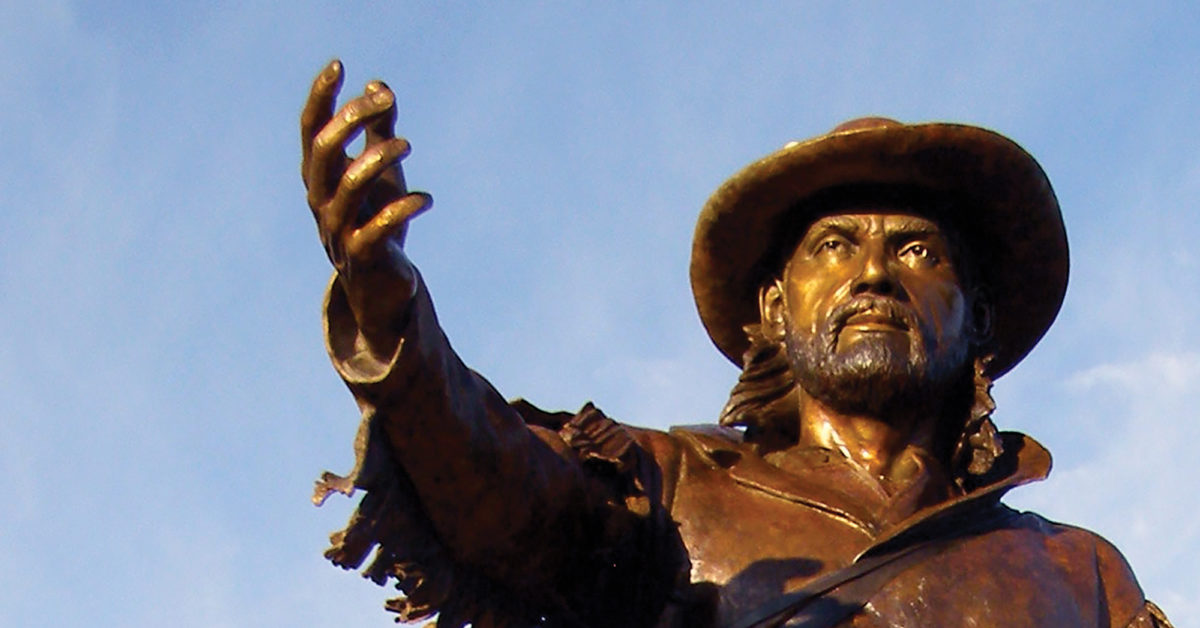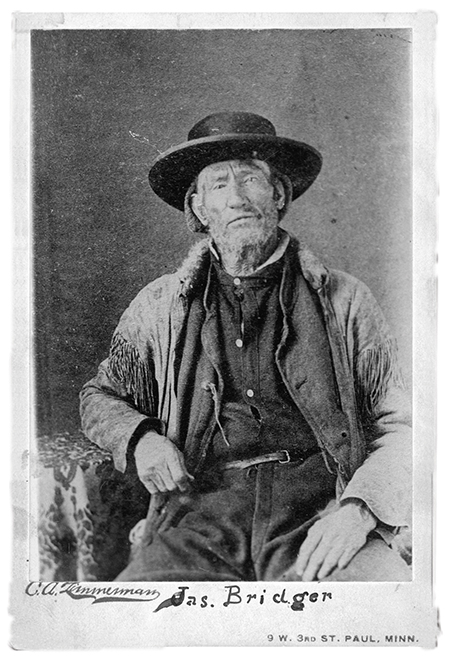
Scattered across the Western United States are sculptures of varying size, accuracy and style that help define one of the archetypal figures of the 19th-century American frontier—the mountain man, whose heyday came during the 1825–40 height of the Rocky Mountain fur trade era.
While period writings, artwork and even photographs survive, the varying degrees of rigor with which sculptors have researched the mountain man—what he looked like, what clothing he wore, the firearms he used and what other equipment he relied on for survival and his livelihood—have resulted in works on a sliding scale between realism and inspired romanticism. The most diligent sculptors have drawn details from the surviving images and written accounts of those who lived and worked as fur trappers, explorers, guides and surveyors. Of course, each sculptor’s own inspired vision also factors into his work.
Several sculptors have rendered statues of Jim Bridger, arguably the most famous of all American mountain men. Virginia-born James Felix Bridger (March 17, 1804–July 17, 1881) made his mark as a trapper, U.S. Army scout, wilderness guide and pathfinder in the decades after Meriwether Lewis and William Clark’s groundbreaking 1804–06 Corps of Discovery expedition to the Pacific Coast. Among other milestones, Bridger was one of the first frontiersmen to explore the Yellowstone region and the Great Salt Lake. In his last year Charles M. Russell (1864-1926), the “Cowboy Artist,” sculpted the lost-wax bronze Jim Bridger, which depicts the mountain man on horseback, clean-shaven, wearing fringed buckskins and a wide-brimmed hat, and raising a rifle as his mount shies away from whatever Bridger is targeting. It is an evocative piece.
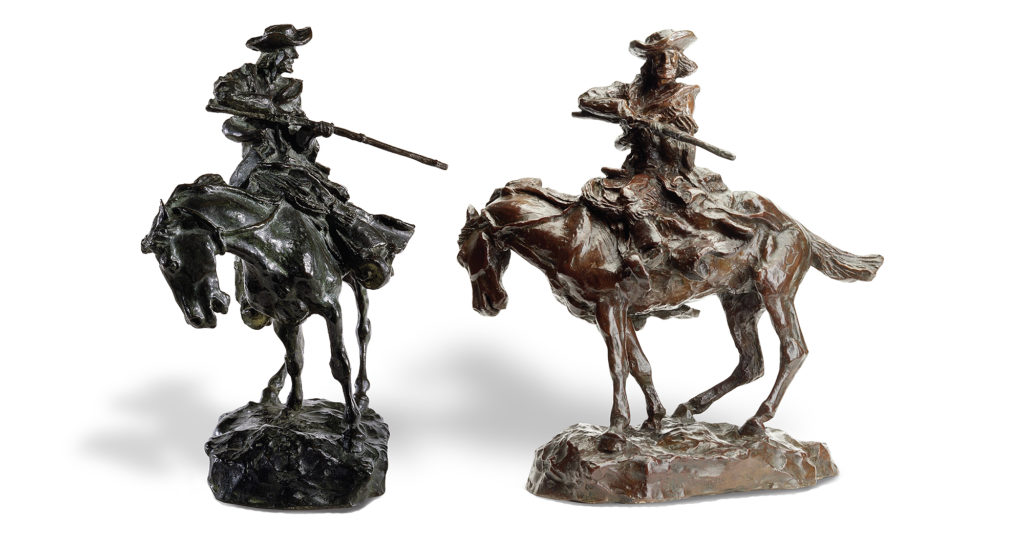
Two present-day sculptors, Ott Jones and Alan David Clark, have also rendered noteworthy sculptures of Bridger that merit a closer look.
Ott Jones, whose bronze Jim Bridger—King of the Mountain Men is on public display in Bozeman, Mont., thoroughly researched earlier images of Bridger, as well as some of the actual items he wore or carried. When considering which items to include in the statue’s final design, the sculptor compiled a comprehensive list:
The well-known circa 1866 black-and-white portrait of Bridger shows the mountain man wearing “infrequent” (i.e., new) buckskins and a wide-brimmed hat
• powder horn made of hollow buffalo horn, slung over his left shoulder;
• patch knife, hung around his neck, used to cut cloth patches to hold the gunpowder and lead ball in his gun;
• large skinning knife with antler handle, tucked beneath his belt;
• hatchet, beneath his belt on his backside;
• “possibles” bag, in which he carried various items like fire-making materials, cloth for lead shot;
• shot bag, hung from his belt in front, which carried lead shot balls;
• hollow antler or horn tip, hung around his neck, used to measure the gunpowder;
• brush and pick (gun tools), hung from his belt;
• cap holder made of leather, hung from his belt;
• castoreum (beaver scent), carried in a buffalo horn tip and hung from his belt;
• trap, a one-spring setup, carried over his right shoulder.
In 2000 Jones identified three items from the collection of the Montana Historical Society (MHS) at Montana’s Museum in Helena that helped him refine his design. Most important was a postcard produced from a well-known circa 1866 black-and-white portrait of Bridger that shows the mountain man wearing “infrequent” (i.e., new) buckskins and a wide-brimmed hat. The postcard was of such poor quality that Bridger appears clean-shaven. Sharper versions of the same image reveal that Bridger in fact sported a short beard. Jones’ modeled his final figure with a full beard and mustache (more on that decision later).
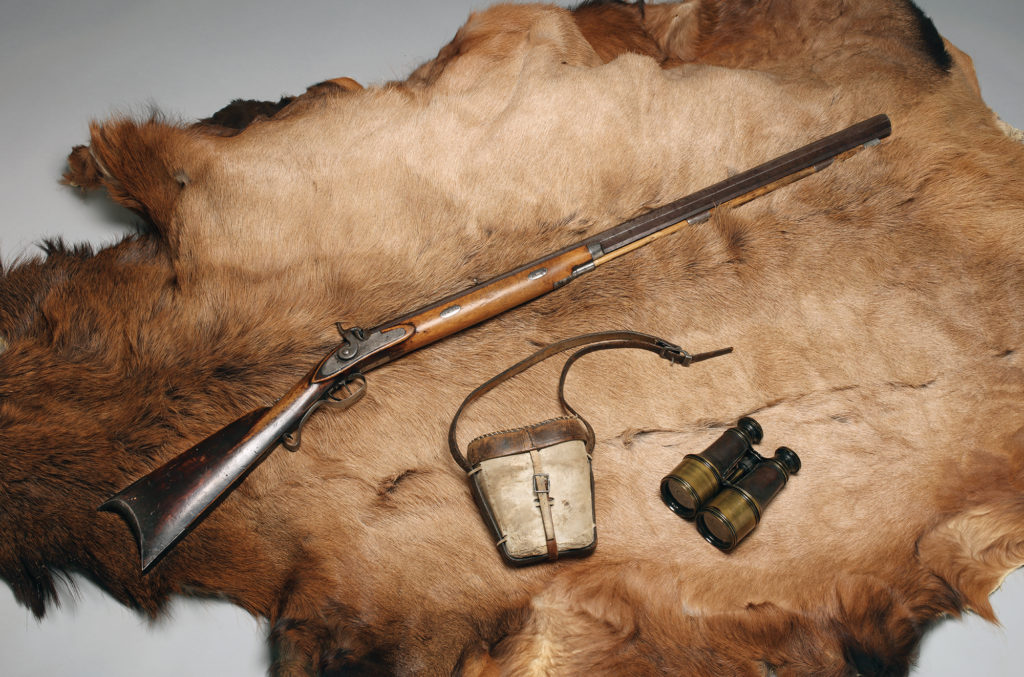
Displayed alongside the postcard were a Hawken rifle, a powder horn and binoculars known to have belonged to Bridger. Jones inspected each item and chose to include the rifle (held in the figure’s left hand up close to the muzzle, its butt resting on the ground) and the powder horn (resting on the figure’s right hip, the strap across his left shoulder). The sculptor chose to omit the binoculars.
Historians have intensively studied and debated the subject of firearms in use during the fur trade era. In his 1967 book Firearms, Traps and Tools of the Mountain Men author Carl P. Russell referred to a rifle once owned by Bridger as “the ‘standard’ percussion Hawken rifle as distributed to the mountain men during the greater part of the period of beaver trade…[resembling] in almost every particular the Hawken rifles once owned by Kit Carson, Mariano Medina, Edwin T. Denig and James Clyman.” Since the publication of Russell’s book, however, firearms historians have challenged his claim about the Hawken, noting that ownership of the famous rifle wasn’t widespread until after 1840, which marked the end of the fur trade era.
With a gun stick made of some hardwood and a good rifle placed in his hands, carrying from 30 to 35 balls to the pound, the reader will have before him a correct likeness of a genuine mountaineer
While items that belonged to Bridger were available to review firsthand, Jones found it more difficult to find contemporary physical descriptions of Bridger or his fur trade cohorts. For help he consulted the 1988 book The Mountain Men, by George Laycock. Laycock includes many details about their accoutrements and appearance, including an especially valuable firsthand description of the typical mountain man from the 1858 book Rocky Mountain Life, by writer and sometime explorer Rufus B. Sage:
His hair, through inattention, becomes long, coarse and bushy and loosely dangles upon his shoulders. His head is surmounted by a low-crowned wool hat or a rude substitute of his own manufacture. His clothes are of buckskin, gaily fringed at the seams with strings of the same material, cut and made in a fashion peculiar to himself and associates. The deer and buffalo furnish him the required covering for his feet, which he fabricates at the impulse of want. His waist is encircled with a belt of leather, holding encased his butcher knife and pistols—while from his neck is suspended a bullet pouch securely fastened to the belt in front, and beneath the right arm hangs a powder horn transversely from his shoulder, behind which, upon the strap attached to it, are affixed his bullet mold, ball screw, wiper, awl, etc. With a gun stick made of some hardwood and a good rifle placed in his hands, carrying from 30 to 35 balls to the pound, the reader will have before him a correct likeness of a genuine mountaineer, when fully equipped.
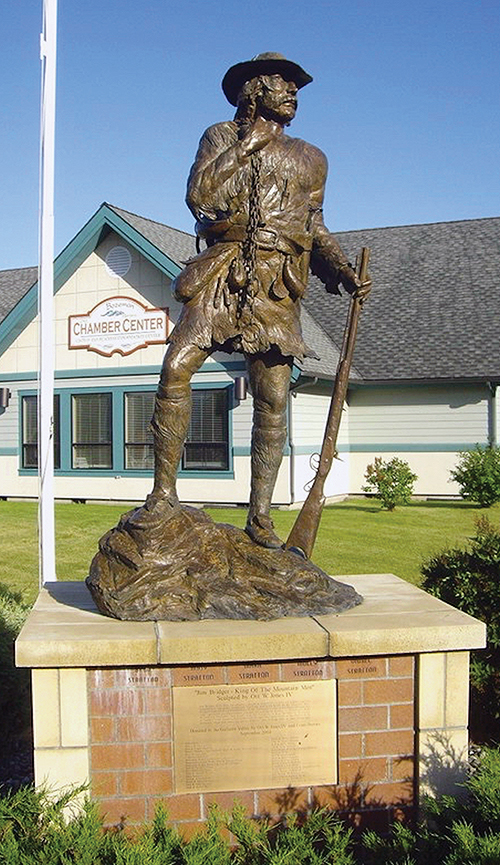
Jones incorporated many of these details in his design, though it is worth noting Sage didn’t explore the region until the early 1840s, after the close of the fur trade era, and published his account nearly 20 years later.
In a chapter of his book titled “King of the Mountain Men,” Laycock includes a bare-bones description of Bridger as “tall, muscular…having a thick neck, high cheekbones, long brown hair, blue-gray eyes and a hooked nose.” Though he doesn’t cite a source, the profile is similar to one found in a 1905 biographical sketch of Bridger by Maj. Gen. Grenville M. Dodge, published in the 1925 book James Bridger, by J. Cecil Alter. As a surveyor for the Union Pacific Railroad, Dodge tapped Bridger for his pathfinding expertise, and the general later employed him as a scout, so his description was from life:
In person [Bridger] was over 6 feet tall, spare, straight as an arrow, agile, rawboned and of powerful frame, eyes gray, hair brown and abundant even in old age, expression mild and manners agreeable.
Central to Jones’ modeling process was how to sculpt his subject’s hair, both on the head and face. The aforementioned MHS postcard, capturing Bridger in his early 60s, was the only authenticated image the sculptor had to reference. Thus Jones rendered Bridger with a head of hair that hung partway to the shoulders. His decision to break with the postcard image and depict the mountain man with a full beard and mustache has borne out as partially correct.
In his biographical sketch Dodge cites the 1866 photo as the “only known portrait” of the mountain man. As reproduced in Alter’s book, the image clearly shows Bridger with a scraggly beard but no mustache. Given that Bridger posed for the portrait more than a quarter century after the peak of the fur trade, Jones took creative license and added a mustache to his figure of a younger Bridger. The only other sculptural elements not sourced to any historical record are two eagle feathers tucked into the mountain man’s hatband.
While Jones strove to make his statue of Bridger as accurate as possible, he did reference both a human skeleton and a live model to render the basic anatomy of a fit, middle-aged man. The resulting figure captures the famed mountain man’s strength of character as reflected in another passage by Dodge:
Bridger was accustomed to carrying metal arrow points in his flesh, to bearing knife and bullet wounds, and to the general discomforts that attended the life of a frontiersman
Bridger was accustomed to carrying metal arrow points in his flesh, to bearing knife and bullet wounds, and to the general discomforts that attended the life of a frontiersman, yet he nevertheless attracted business by his natural graciousness.
Dodge also described the 7-foot-tall granite monument at Bridger’s gravesite at Mount Washington Cemetery in Kansas City, Mo. The general was the patron for the monument, which officials dedicated on Dec. 11, 1904, just before Dodge published his biographical sketch. On its face, above a summary of Bridger’s storied career, is a sculpted bust of the mountain man in relief, clearly adapted from the 1866 portrait. The identity of its sculptor is unknown. Regardless, as Jones confirms, “I never used the gravesite for any of my research.”
Having settled on a design, Jones first had his depiction of Bridger cast into maquettes (scale model sculptures) for two commercial editions; the first was 13 inches tall, the second 23 inches tall. In 2003, to cast his final, monumental model in bronze, the sculptor turned to Northwest Art Casting foundry in Bozeman. Gifted by the sculptor to the people of Gallatin County, the statue was unveiled in September 2004 outside the Bozeman Area Chamber of Commerce visitor center, at N. 19th Street and Baxter Lane. Standing atop a 3-foot-tall brick-and-stone pedestal, with the eponymous Bridger Mountains visible in the distance, Jones’ 8-foot-tall bronze serves as fitting tribute to the iconic figure of the Rocky Mountain fur trade era. It is also a credit to Jones’ efforts to include historical details both specific to Bridger and in keeping with written accounts of the period.
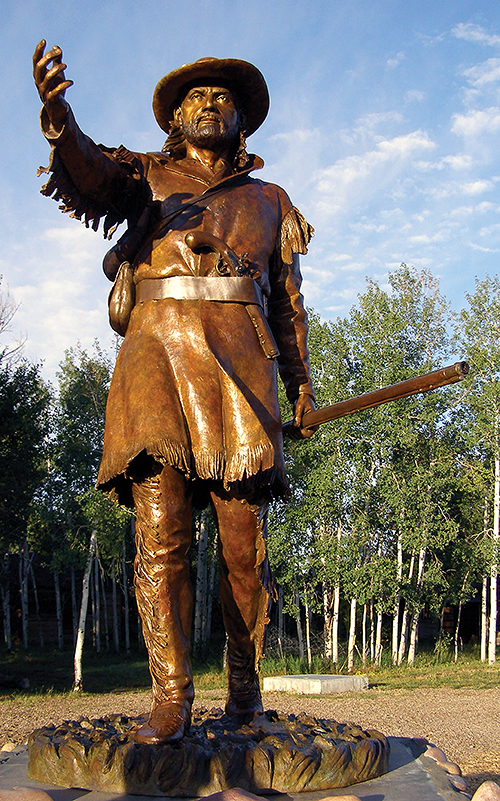
David Alan Clark’s monumental bronze Jim Bridger stands at the entrance to Fort Bridger State Historic Site, in the southwest corner of Wyoming. It is a fitting locale, as Bridger and partner Louis Vasquez first established the site in 1843 as a fur trading outpost and resupply point on the Oregon Trail. During the 1857–58 Utah War the mountain man turned scout leased the site to the Army, which occupied it off and on until 1890, when Wyoming was admitted to the Union.
In 2004 Clark approached the Fort Bridger Historical Association with his concept for a sculpture at the historic site. Receptive to the idea, the association commissioned the sculptor and began raising funds to cover the cost of the design process and foundry casting of the 8-foot-tall statue. As expressed on his website, Clark considers research an integral and enjoyable part of any new project:
I believe that the best public art is the result of collaboration between my client and myself. My partner (and wife), M.J., and I love researching each new commission, developing novel ways to express the spirit of the place and working closely with our clients to create a unique and timeless work of art.
By Clark’s own admission, while his portfolio is “broad and figurative,” he is “not a Western artist.” Thus, while researching and designing the Bridger statue, he and his wife sought the input of two Wyoming-based experts—Martin Lammers, historian of the state historic site, and A. Dudley Gardner, a professor of history and political science at Western Wyoming Community College. Their collaboration continued through 2006, when the sculptor completed his initial maquette.
While modeling the face, Clark referenced the same 1866 portrait of an elderly Bridger used by Ott Jones, though he too rendered his subject as a middle-aged man, representing Bridger at the time he established the fort in 1843. Clark obtained his copy of the photo from Kansas City’s Mount Washington Cemetery, site of the mountain man’s grave and the 1904 memorial erected by Grenville Dodge.
While researching Bridger’s stature and other physical traits, Clark also drew on Dodge’s 1905 biographical sketch, but he and Lammers discovered another contemporary description. An excerpt from the 1996 book News of the Plains and Rockies, 1803–1865, by David A. White, describes Bridger from his days as a guide, sitting around a campfire. Left with the impression the mountain man had an “Olympic-caliber body,” Clark modeled his statue in kind.
Clark and team took great care to research items worn or carried by mountain men. For example, the sculptor personally inspected a J. Henry English-pattern flintlock trade rifle, a variation of which Vasquez presented to Bridger in 1853. Clark’s figure grasps the rifle in his left hand and has a similar-vintage flintlock pistol tucked in his belt. The flints in the jaws of both guns’ hammers are wrapped in red flannel—a thoughtful historical detail. The powder horn resting on Bridger’s right hip is based on another period artifact inspected by the artist. Other period-specific details include “pucker toe” moccasins, a trade knife in a leather sheath and a “possibles” bag.
As representative models of the mountain man character, the Jim Bridger sculptures by Jones and Clark serve to visually enhance the history of the fur trade era
Two years passed from the time Clark completed his maquette till the final, monumental model was ready for the casting process. In the interim the sculptor examined the Western works of 19th-century painters Arthur Fitzwilliam Tait (notably Trappers at Fault—Looking for the Trail) and Alfred Jacob Miller for a glimpse at frontier figures, gear and clothing. Throughout the design and modeling process Clark was impressed at how the local community of mountain men enthusiasts (a “most discerning audience”) got behind the effort. He credits their input with determining, for example, the choice of firearms presented (flintlock vs. percussion).
Cast by the Eagle Bronze foundry of Lander, Wyo., using the lost-wax method, Clark’s Jim Bridger was dedicated on Aug. 8, 2008. Facing the intersection of Main Street and I-80 business in Fort Bridger, the workmanlike statue stands with its right hand outstretched and uplifted, conveying Bridger’s identity as a guide without equal showing the way.
As representative models of the mountain man character, the Jim Bridger sculptures by Jones and Clark serve to visually enhance the history of the fur trade era, both implicitly as outcomes of their surrounding communities and explicitly as models of a character that unquestionably impacted the history of the West. WW
Fred F. Poyner IV is a Seattle-based historian and author with nearly 30 years of experience researching and writing about the art and history of the Pacific Northwest, including his two most recent books, Pacific Fishermen Inc.: 150 Years of Norwegian Heritage Shipbuilding (2020) and Portland Public Sculptors: Monuments, Memorials and Statuary, 1900–2003 (2021). For further reading he recommends James Bridger: Trapper, Frontiersman, Scout and Guide—A Historical Narrative, by J. Cecil Alter and Grenville M. Dodge; Journal of a Trapper, or, Nine Years in the Rocky Mountains, 1834–1843, by Osborne Russell (edited by Aubrey L. Haines); Jim Bridger: Mountain Man, by Stanley Vestal; and Jim Bridger: Trailblazer of the American West, by Jerry Enzler.

